Samsung Electronics Co SCHA915 Dual-Band CDMA Phone with Bluetooth User Manual
Samsung Electronics Co Ltd Dual-Band CDMA Phone with Bluetooth
Users Manual
9. User Manual

World Wide Web
http://www.samsungmobile.com
Printed in Korea
Code No.:GH68-XXXXXA
English. 10/2005. Rev 1.0
* Depending on the software installed or your service provider. some of the descriptions in this manual may differ
from your phone.
* Depending on your country, your phone and accessories may appear different from the illustrations in this menual.

SCH-A915
User’s Manual
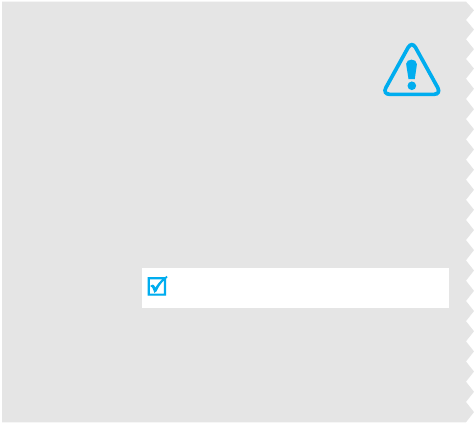
Use road safety at all times
Do not use a hand-held phone while driving. Park
the vehicle first.
Switch off the phone when refuelling
Do not use the phone at a refuelling point (service
station) or near fuels or chemicals.
Switch off in an aircraft
Wireless phones can cause interference. Using them
in an aircraft is both illegal and dangerous.
Switch off the phone near all medical
equipment
Hospitals or health care facilities may be using
equipment that could be sensitive to external radio
frequency energy. Follow any regulations or rules in
force.
Important
safety
precautions
Failure to comply with the following
precautions may be dangerous or illegal.

Important safety precautions
1
Interference
All wireless phones may be subject to interference,
which could affect their performance.
Be aware of special regulations
Meet any special regulations in force in any area and
always switch off your phone whenever it is forbidden
to use it, or when it may cause interference or danger.
Water resistance
Your phone is not water-resistant. Keep it dry.
Sensible use
Use only in the normal position (held to the ear). Avoid
unnecessary contact with the antenna when the phone
is switched on.
Emergency calls
Key in the emergency number for your present
location, then press the SEND key.
Keep your phone away from small children
Keep the phone and all its parts, including accessories,
out of the reach of small children.
Accessories and batteries
Use only Samsung-approved accessories and
batteries. Use of any unauthorised accessories could
damage your phone and may be dangerous.
Qualified service
Only qualified service personnel may repair your
phone.
For more detailed safety information, see "Health and
safety information" on page 42.
• The phone could explode if the battery is
replaced with an incorrect type.
• Dispose of used batteries according to the
manufacturer’s instructions.
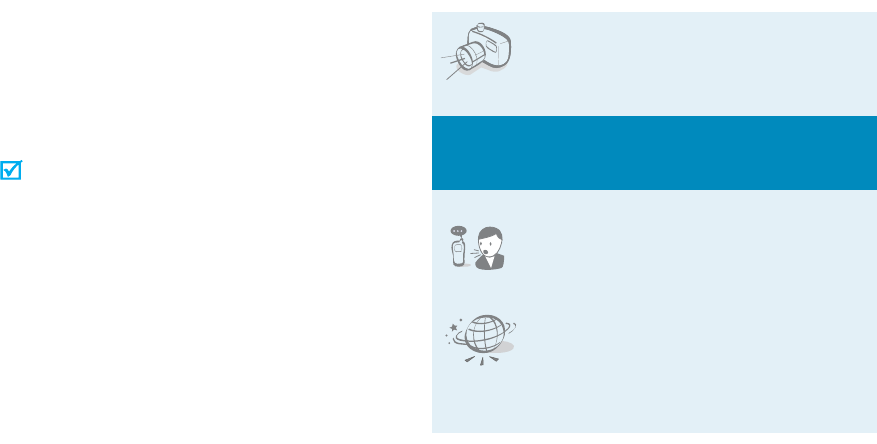
2
About this Guide
This User’s Guide provides you with condensed
information about how to use your phone. To quickly
learn the basics for your phone, please refer to “Get
started” and “Step outside the phone.”
In this guide, the following instruction icons appear:
Indicates that you need to pay careful
attention to the subsequent information
regarding safety or phone features.
Indicates that you can get more information
on the referenced page.
→
Indicates that you need to press the
Navigation keys to scroll to the specified
option and then select it.
[ ] Indicates a key on the phone. For example,
[
OK
]
< > Indicates a soft key, whose function is
displayed on the phone screen. For example,
<
Menu
>
• Camera and camcorder
Use the camera module on your
phone to take a photo or record a
video.
Special
features of your phone
• Voice recognition
Dial a number or access features
with voice commands.
•WAP browser
Access the wireless web and access
various services and current
information.

3
Special features of your phone
• Get personal with photo caller
ID
See who’s calling you when their
very own photo displays.
• Name card
Create name cards with your
number and profile. Whenever
introducing yourself to others, use
this convenient electronic name
card.
• Multimedia Message Service (MMS)
Send and receive MMS messages with a
combination of text, images, video, and audio.
•Stopwatch
Measure the time it takes to do
your exercise or work
•Calendar
Keep track of your daily, weekly,
and monthly schedule.
• Voice recorder
Record memos or sounds.
•Bluetooth
Transfer media files and personal data
and connect to other devices using
free, wireless Bluetooth technology.

4
Contents
Unpack 6
Make sure you have each item
Get started 6
First steps to operate your phone
Install and charge the phone ................................... 6
Power on or off...................................................... 7
Access menu functions............................................ 8
Customise your phone ............................................ 9
Make/Answer calls................................................ 11
Step outside the phone 11
Begin with your camera, and other special features
Use camera......................................................... 11
Use Contacts ....................................................... 12
Browse the web ................................................... 14
Send messages.................................................... 14
View messages.................................................... 15
Use voice recognition............................................ 16
Enter text 17
T9 English, Alphabet, 123, and Symbols mode
Call functions 19
Advanced calling features
Menu functions 23
All menu options listed
Health and safety information 42
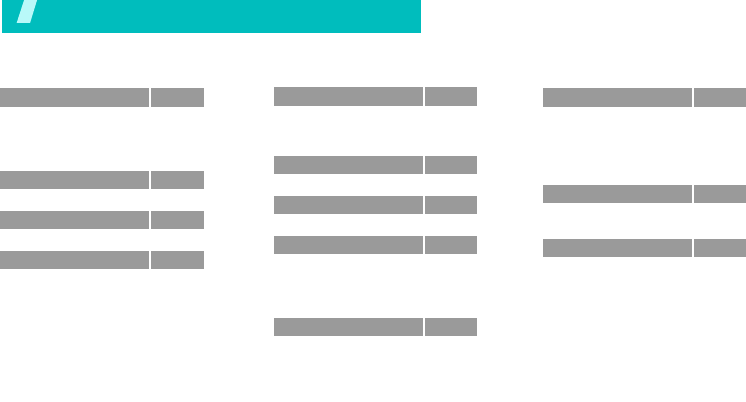
5
Overview of menu functions
To access Menu mode, press <
Menu
> in Idle mode.
1 Calls
p.23
1 Missed
2 Incoming
3 Outgoing
4 Call Timers
p.23
p.23
p.23
p.23
2 Downloads
p.23
3 WAP
p.25
4 Torpedos
p.26
1 New Torpedo
2 Inbox
3 Outbox
4 Voice Mail
5 Templates
6 WAP Alerts
7 Drafts
8 Settings
9 Memory Info
p.26
p.27
p.27
p.27
p.27
p.27
p.28
p.28
p.29
5 Play 3G
p.29
1 Player 3G
2 MP3 Player
3 My Files
p.29
p.29
p.29
6 Meu Vivo
p.29
7
7 Voicemail
p.30
8 Messaging
p.30
1 Chat
2 Messenger
3 E-Mail
4 Torpedos
p.33
p.33
p.33
p.33
9 Utilidades
p.30
10 Voice Services
p.30
1 Voice Portal
2 Voice Information
3 Voice Command
4 Voice Memo
5 Settings
p.31
p.31
p.31
p.32
p.32
11 Other Functions
p.33
1 Planner
2 Help
p.31
p.31
12 Settings
p.34
1 Display
2 Sounds
3 Call Setup
4 Language
5 Vivo Encontra
6 WAP Setup
7 Security
8 System
9 Bluetooth
p.34
p.36
p.37
p.37
p.37
p.37
p.38
p.39
p.40
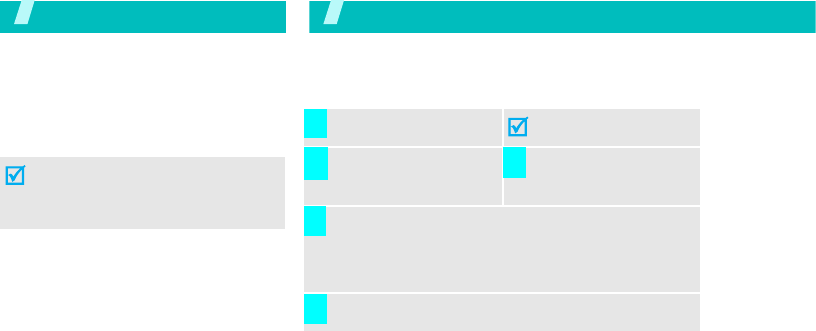
6
Unpack
Make sure you have each item
You can obtain various accessories from
your local Samsung dealer.
Phone Travel Adapter
Battery User Manual
The items supplied with your phone
and the accessories at your Samsung
dealer may vary, depending on your
country or service provider.
Get started
First steps to operate your phone
Install and charge the phone
Low battery indicator
When the battery is low:
• a warning tone sounds,
Install the battery. To remove the battery:
Plug the travel adapter
into the phone. Plug the adapter into a
standard AC wall
outlet.
When the phone is completely charged (the battery
icon stops blinking), unplug the adapter from the
power outlet.
Remove the adapter from the phone.
1
2 3
4
5
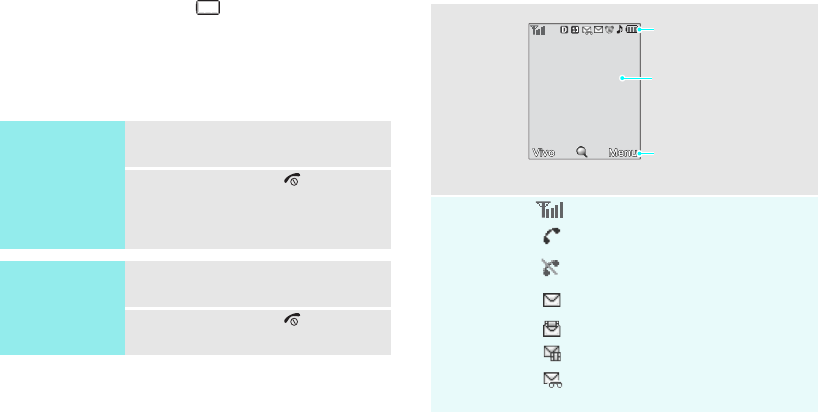
7
• the battery low message displays, and
• the empty battery icon blinks.
If the battery level becomes too low, the phone
automatically turns off. Recharge your battery.
Power on or off
Display
Switch on
Do not turn on
the phone when
mobile phone
use is prohibited.
1. Open the phone.
2. Press and hold [
]
to turn on
the phone.
Switch off
1. Open the phone.
2. Press and hold [
]
.
Layout
Iocns
Received signal strength
Call in progress
Out of your service area; you
cannot send or receive calls
New SMS message
New MMS message
New SMS & MMS message
New voice mail
Text and graphics
display messages,
instructions, and
information you enter.
Soft key function indicators
show the current functions
assigned to the two soft
keys.
Icons
display various icons.
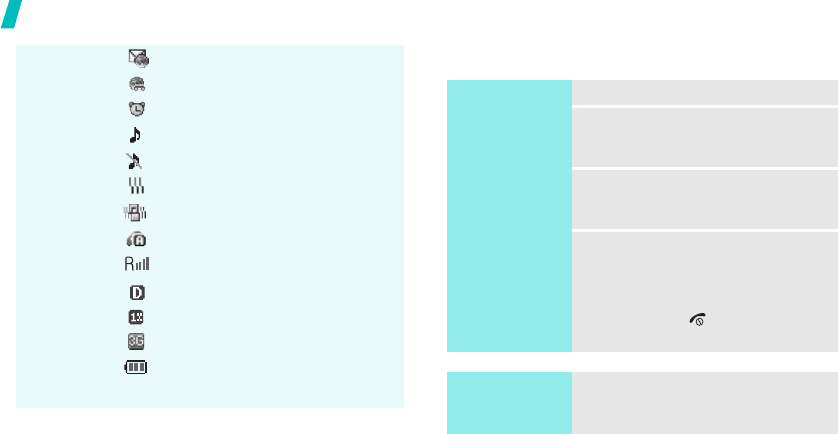
8
Get started
Access menu functions
Icons
(continued)
New WAP push message
New WAP push & Voice mail
Alarm set
Ringer on
Ringer type set to Silent
Ringer type set to Vibration
Silent mode is active
Auto answer mode is acive
Roaming network
Digital mode is active
1x RTT mode is active
EVDO mode is active
Battery power level
Select an
option
1. Press the appropriate soft key.
2. Press the Navigation keys to
move to the next or previous
option.
3. Press <
Select
> or [
OK
] to
confirm the function displayed
or option highlighted.
4. To exit, choose either of the
following methods.
•Press <
Back
> or [
CLR
] to
move up one level.
•Press [
]
to return to Idle
mode.
Use shortcuts
Press the number key
corresponding to the option you
want.

9
Get started
Customise your phone
1. In Idle mode, press <
Menu
>
and select
Settings
→
Language
.
2. Select a language.
1. In Idle mode, press <
Menu
>
and select
Settings
→
Sounds
→
Type
→
Call
.
2. Select a ringer category.
3. Select a ringer melody.
4. Press <
Select
> or [
OK
].
Display
language
Call ringer
melody
You can set a wallpaper for the
main or external display.
1. In Idle mode, press <
Menu
>
and select
Settings
→
Display
→
Idle Screen
→
Wallpaper
.
2. Select an image category.
3. Select an image.
4. Press <
Select
> or [
OK
].
Idle mode
wallpaper
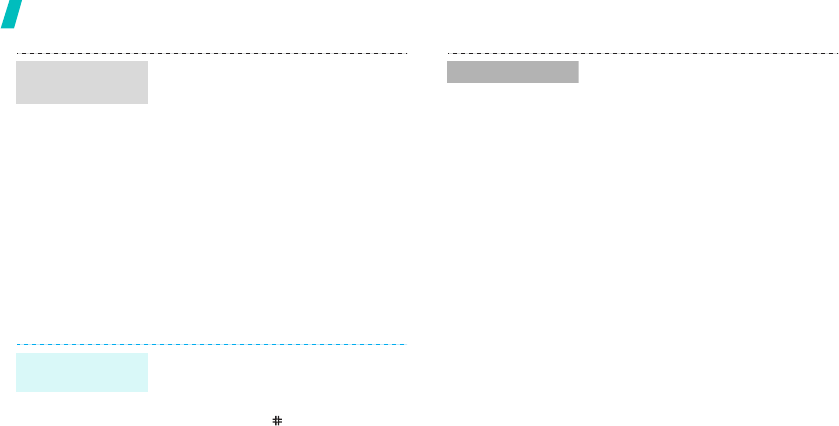
10
Get started
You can change the banner on the
display.
1. In Idle mode, press <
Menu
>
and select
Settings
→
Display
→
Idle Screen
→
Banner
.
2. Scroll to
Enable
and press
[Down].
3. Enter your banner message and
press [Down].
4. Select a text color.
5. Press <
Preview
> to preview
your banner.
6. Press <
Select
> or [
OK
].
You can switch to silent mode to
avoid disturbing other people with
your phone sound.
Press and hold
[
]
in Idle mode.
Display
Banner
Silent mode
You can protect the phone against
unauthorized use with a phone
password.
1. In Idle mode, press <
Menu
>
and select
Settings
→
Security
.
2. Enter the default password,
“0000.”
3. Select
Change Pwd
and enter
the default password.
4. Enter a new password.
5. Enter the new password again.
6. Select
Lock Phone
.
7. Select
On Power-Up
or
Lock
Now
.
Phone lock
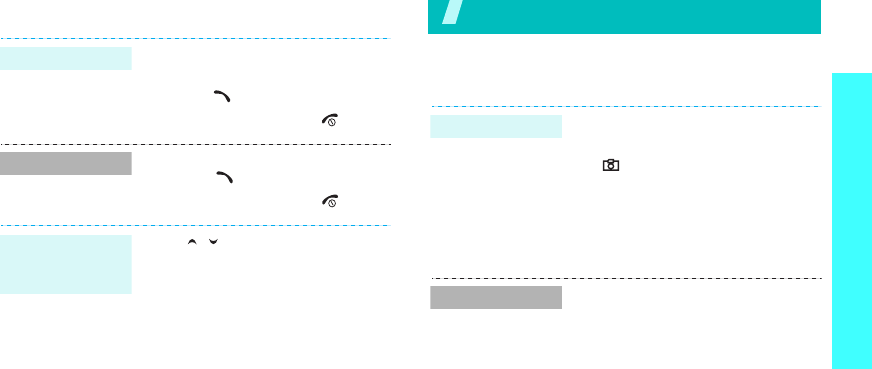
11
Step outside the phone
Make/Answer calls
Step outside the phone
Begin with your camera, and other special features
Use camera
1. Enter an area code and phone
number.
2. Press
[
].
3. To end the call, press
[
].
1. When the phone is ringing,
press [ ] or <
Answer
>.
2. To end the call, press
[
].
Press [ / ].
Make a call
Answer a call
Adjust the
volume during
a call
1. Open the phone.
2. In Idle mode, press and hold
[ ] to turn on the camera.
3. Aim the lens at the subject and
adjust the image.
4. Press [
OK
] to take a photo.
5.
Pres
s [
OK
] to save the photo
.
1. In Capture mode, press
<
Mode
> and select
My
Pictures
.
2. Press [Left] or [Right] to select
a photo album and press
[Down].
3. Scroll to a photo you want and
press <
View
>.
Take a photo
View a photo

12
Step outside the phone
Use Contacts
1. In Idle mode, press and hold
[ ] to turn on the camera.
2. Press <
Mode
> and select
Camcorder
.
3. Press [
OK
] to start recording.
4. Press [
OK
] to stop recording.
5.
Pres
s [
OK
] to save the video.
1. In Record mode,
press <
Mode
>
and select
My Videos
.
2. Press [Left] or [Right] to select
a video category and press
[
Down
] .
3. Scroll to a video clip you want
and press <
View
>.
Record a video
Play a video
As a new entry
1. In Idle mode, enter a phone
number and press [
OK
].
2. Select
New Entry
→
a number
type.
3. Specify the contact information:
Name, Mobile, Work, Home,
Pager, Fax, Email, URL, Group,
Ringer, Birthday, Memo and
Picture.
4. Press [
OK
] to save the entry.
Add an entry

13
To an existing entry
1. In Idle mode, enter a phone
number and press [
OK
].
2. Select
Existing Entry
.
3. Select an entry from the
Contacts list.
4. Select a number type.
5. Press [
OK
] to save the entry.
1. In Idle mode, press [
OK
].
2. Select an entry.
3. Select a number and press
[
]
to dial, or press
<
Options
> to access options.
Add an entry
(continued)
Find an entry
1. In Idle mode, press
<
Contacts
> and select
Owner Info
.
2. Press <
Options
> and select
Edit
.
3. Specify your contact
information.
4. Press <
Save
> to save the
name card.
5. After saving the name card,
press <
Options
> and select
Send vCard
.
Create and
send a name
card

14
Browse the web
Using a built-in WAP (Wireless Access Protocol)
browser, you can get easy access to the wireless web
to get a variety of up-to-date services and information
and to enjoy downloads of web content.
Send messages
In Idle mode, press <
Menu
> and
select
WAP
• To access browser options,
press <
Menu
> and select
Browser Menu
.
• To scroll through browser items,
press the Navigation keys.
• To select an item, press <
OK
>.
• To return to the previous page,
press [
CLR
] or <
Cancel
>.
• To return to the home page,
press and hold [
CLR
].
Launch the
browser
Navigate with
the WAP
browser
1. In Idle mode, press <
Menu
>
and select
Torpedo
s
→
New
Torpedo
→
Torpedo SMS
.
2. Enter destination numbers and
press [
OK
].
3. Enter the message text and
press [
OK
].
4. Press <
Send
>.
Send a text
message (SMS)

15
Step outside the phone
View messages
1. In Idle mode, press <
Menu
>
and select
Torpedo
s
→
New
Torpedo
→
Foto Torpedo
or
Video Torpedo
.
2. Enter destination numbers and
press [
OK
].
3. Select
Add Image
or
Add
Sound
and add a media file.
For
Video Torpedo
, select
Add
Video
and add a video clip.
4. Select
Add Message
/
Add
Subject
and enter the message
text and subject.
5. Select
Attach
to add an entry
as name card format.
6. Press <
Send
>.
Send a
multimedia
message
(MMS)
When a notification appears:
Press <
Read
>. The message
displays.
From the Inbox:
1. In Idle mode, press <
Menu
>
and select
Torpedo
s
→
Inbox
.
2. Select a message.
When a notification appears:
Press <
Down
>. The message will
be downloaded and displayed.
From the Inbox:
1. In Idle mode, press <
Menu
>
and select
Torpedo
s
→
Inbox
.
2. Select a message.
View a text
message
View a
multimedia
message

16
Step outside the phone
Use voice recognition
Your phone can recognize specific voice commands in
order to dial a number or access features.
1. In Idle mode, press and hold
[].
2. Say “Voice Dial.”
3. Say a name or phone number.
4. If the name you hear is not
what you want, say “No.”
5. Say “Yes” when you hear what
you want.
If the name has more than one
number, select the number type
you want.
Voice dialing
1. In Idle mode, press and hold
[].
2. Say one of the following
commands.
•
Voice Dial
: begin voice
dialing.
•
Memo
: record a voice
memo.
•
Contacts
: open the
Contacts list.
•
Voice Mail
: access the
Voice Mail
menu.
•
Voice Portal
: access the
Voice Portal
menu.
•
My Phone #
: check your
phone number.
Access
features
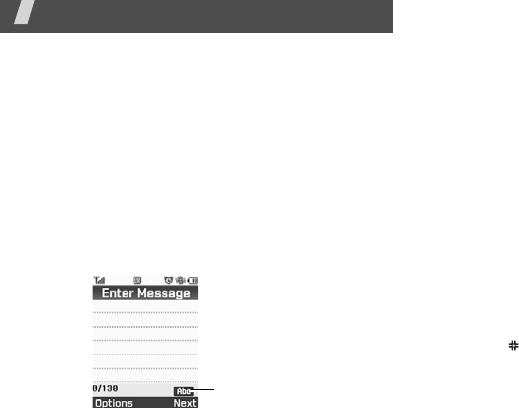
17
Enter text
T9 English, Alphabet, 123, and Symbols mode
You can enter text for some features such as
messaging, Contacts, or Planner, using T9 English
mode, Alphabet mode, 123 mode, and Symbols mode.
Changing the text input mode
The text input mode indicator appears when the cursor
is in a text field.
•Press <
Options
> to select to T9 English,
Alphabet, or 123 mode.
Example:
Writing a text message
Using T9 English mode
T9 is a predictive text input mode that allows you to
key in any character using single keystrokes.
Entering a word in T9 English mode
1. Press [
2
] to [
9
]
to start entering a word. Press
each key once for each letter.
For example, press [
4
], [
3
], [
5
], [
5
], and [
6
] to
enter Hello in T9 English mode.
T9 predicts the word that you are typing, and it
may change with each key that you press.
2. Enter the whole word before editing or deleting
characters.
3. When the word displays correctly, go to step 4.
Otherwise, press [
0
] to display alternative word
choices for the keys that you have pressed.
For example, Of and Me use [
6
] and [
3
].
4. Press [ ] to insert a space and enter the next
word.
Text input mode
indicator
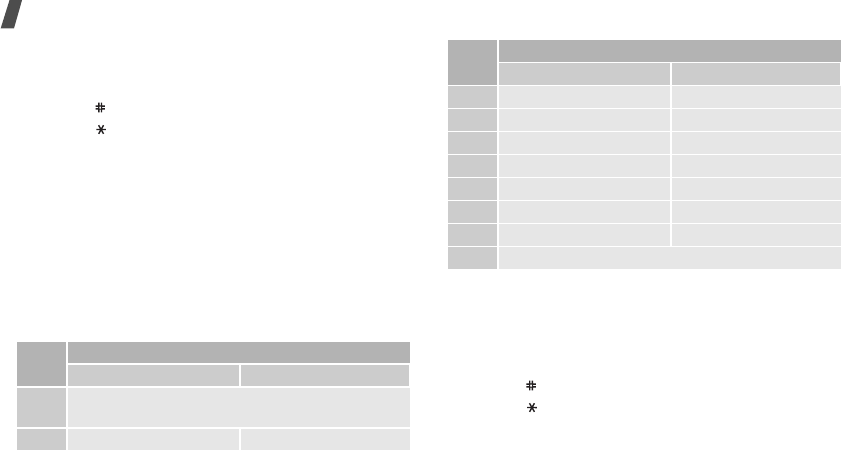
18
Enter text
Tips for using T9 English mode
• Press [
1
] to enter periods or apostrophes
automatically.
• Press [ ] to insert a space.
• Press [ ] to change case. Lower case (
abc
),
Initial capital (
Abc
), and Capital lock (
ABC
) are
available.
• Press [
CLR
] to delete characters one by one. Press
and hold [
CLR
] to clear the display.
• To type words not found in T9 English mode,
change the text input mode to Alphabet mode.
Using Alphabet mode
Press the appropriate key until the character you want
appears on the screen.
Tips for using Alphabet mode
• To enter the same letter twice or to enter a
different letter on the same key, wait for the cursor
to move to the right automatically or press [Right].
Then, enter the next letter.
• Press [ ] to insert a space.
• Press [ ] to change case. Lower case (
abc
),
Initial capital (
Abc
), and Capital lock (
ABC
) are
available.
Key
Characters in order displayed
Upper case Lower case
1
. @ ? ! - , & : ’
(carriage return) 1
2
A B C 2 a b c 2
3
D E F 3 d e f 3
4
G H I 4 g h i 4
5
J K L 5 j k l 5
6
M N O 6 m n o 6
7
P Q R S 7 p q r s 7
8
T U V 8 t u v 8
9
W X Y Z 9 w x y z 9
0
0
Key
Characters in order displayed
Upper case Lower case
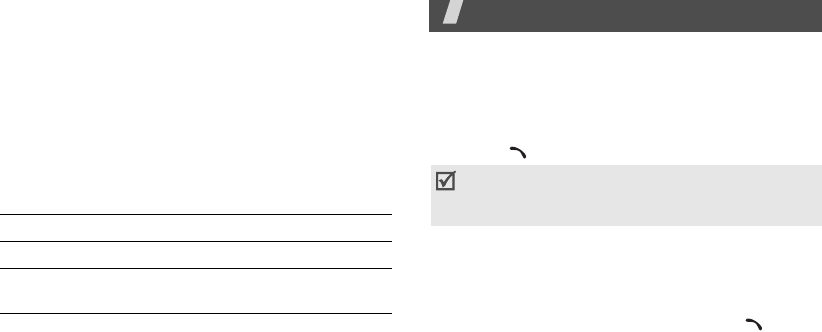
19
•Press [
CLR
] to delete characters one by one. Press
and hold [
CLR
] to clear the display.
Using 123 mode
123 mode enables you to enter numbers.
Press the keys corresponding to the digits you want.
Using Symbol mode
Symbol mode enables you to insert symbols.
Press <
Options
> and select
Symbols
.
Call functions
Advanced calling features
Making a call
1. In Idle mode, enter the area code and phone
number.
2. Press [
]
.
Using the dialing options
While entering a number, press <
Options
> to access
the following options:
•
Hard Pause
: insert a hard pause. Numbers after
the pause will be sent when you press [
]
.
•
2 sec. Pause
: insert a 2-second pause. Numbers
after the pause will be sent automatically.
•
Send
: send message to the number.
To Press
display more symbols the Navigation keys.
select a symbol the corresponding
number key.
Press
[
CLR
]
to clear the last digit or press and hold
[
CLR
]
to clear the whole display. You can move the
cursor to edit an incorrect digit.

20
Call functions
•
Save
: save the number to Contacts.
Redialing recent numbers
1. In Idle mode, press [
]
to display the list of
recent numbers.
2. Scroll to the number you want to dial and press
[
]
.
Making a call from Contacts
Once you have stored a number in Contacts, you can
dial the number by selecting it from Contacts.
You can also use the speed dial feature to assign your
most frequently called phone numbers to specific
numbers. You can quickly dial them by pressing the
associated number keys.
Making an emergency call
You can make calls to standard emergency numbers,
such as 190, 192, or 193 on the Emergency # list,
even if your phone is locked or all outgoing calls are
restricted.
Voice dialing
Once you have stored a phone number in Contacts,
you can dial it simply by stating the associated name
or the number.
Before using the voice dial feature, you can
programme your phone to better recognize your voice
in the
Settings
menu.
1. In Idle mode, open the phone or press and hold
[ ], depending on the setting in the
Voice
Launch
menu.
2. At a prompt, say “Voice Dial.”
3. State a name or phone number to the microphone.
4. When the phone ask for confirmation, say one of
the following commands:
•
Yes
to confirm the name.
•
No
to skip to another name.
•
Repeat
to start over with another command.
•
Cancel
to end the voice recognition.
5. Say the number type you want, if the name has
more than one number.

Call functions
21
Speed dialing
When you store a number in Contact, a location
number is assigned to the number so that you can dial
it by entering its location number.
• For 1-digit locations, hold down the corresponding
number key.
• For other locations, press the first number key and
hold down the last number key.
Ending a call
Close the phone or press [
]
.
Answering a call
When you receive an incoming call, the phone rings
and displays the incoming call image.
Press [
]
or <
Answer
> to answer the call.
Tips for answering a call
• When
Send Key
in the
Call Answer
menu is
selected, you can press [
]
or <
Answer
>.
• When
Folder Open
in the
Call Answer
menu is
selected, you can simply open the phone.
• When
Any Key
in the
Call Answer
menu is
selected, you can press any key, except [
],
Volume keys, and soft keys.
• Press <
Ignore
> to reject a call.
• Press and hold [ / ] to mute a call ringer.
Viewing missed calls
If you have missed calls, the screen displays how
many calls you have missed.
Press [
]
to dial the number you want.
Using the headset
Use the headset to make or answer calls without
holding the phone.
Connect the headset to the jack on the left side of the
phone.

22
Call functions
The buttons on the headset work as listed below:
Options during a call
You can access a number of functions during a call.
Adjusting the volume during a call
Use [ / ] to adjust the earpiece volume during a call.
Press [ ] to increase the volume level and [ ] to
decrease the volume level.
Answering a second call
You can answer an incoming call while already on the
phone, if your network supports it.
1. Press [
]
to answer the call. The first call is
automatically put on hold.
2. Press [
]
to switch between the calls.
Making a three-way call
If you have activated the three-way calling service,
you can have conversation with two people
simultaneously.
1. During a call, make another call or answer a
second call. The first caller is placed on hold.
2. Press [
]
to begin with the three-way call.
Switching off the microphone
(Mute mode)
You can temporarily switch off your phone’s
microphone so that the person on the phone cannot
hear you.
• Press <
Mute
> or <
Unmute
>.
To Press
redial the last call the button twice.
answer a call and hold the button.
end a call and hold the button.

23
Menu functions
All menu options listed
Calls
(Menu 1)
Use this menu to view the calls you have missed,
received, or dialled, and the length of your calls.
To access this menu, press <
Menu
> in Idle mode and
select
Calls
.
Missed
(Menu 1.1)
This menu displays the most recent calls that you did
not answer.
Accessing a call record
1. Press [Up] or [Down] to scroll through the call list.
2. Press [
OK
] to view the details of a call, or [
]
to
dial a number.
Incoming
(Menu 1.2)
This menu displays the most recent calls you have
received.
Outgoing
(Menu 1.3)
This menu displays the most recent calls you have
dialled.
Call Timers
(Menu 1.4)
Use this menu to display the total length of all
outgoing and incoming calls. The actual time invoiced
by your service provider will vary.
You can check the length of your last call and the total
time of calls you have made to or received, since the
phone was shipped from the factory.
Downloads
(Menu 2)
You can download various Brew applications and
multimedia files, such as melodies and images. You
can also store and manage them.
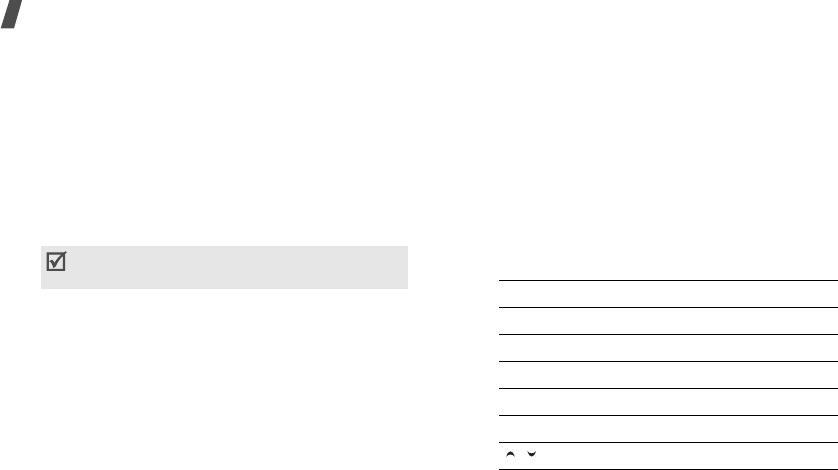
24
Menu functions
Downloading applications
1. Select
Download Center
.
The following menu is available:
•
Catalog
: browse the server and purchase
applications.
•
Search
: enter a keyword to search for a
specific application.
•
About Download
: display help information
about using the
Download Center
menu.
2. Select
Catalog
.
3. Select an application you want to download and
follow the instructions on the screen.
Using the Media player
Using the Media player, you can play downloaded files
or video clips you have recorded. You can also access
the websites preset by your service provider and play
media files.
Playing media content
1. Select
Media Player
.
2. Press <
Menu
> to access the following folder list.
Music
: save downloaded music files.
Video
: save downloaded video files.
My videos
: save video clips you have recorded.
VoD/MoD
: save URL addresses preset by your
service provider. You can directly access the preset
websites.
3. Select a folder and scroll to the file you want.
4. Press [
OK
] to play the file
During playback,Use the following keys:
When
Airtime Warnings
is set to
All Enabled
,
you are prompted to connect to the server.
Keys Function
OK
Pauses/resumes playback.
Up Exits the Media player.
Down Stops playback.
Left Skips backward through a file.
Right Skips forward through a file.
/ Adjust the volume.

Menu functions
WAP
(Menu 3)
25
Accessing media content information
1. In the Media player screen, press <
Menu
> and
select a folder.
2. Scroll to the media content you want to access
and press [
Right
].
• While viewing the information, you can delete
the media content by pressing <
Erase
>.
Changing the player settings
1. Select Media Player.
2. Press <
Menu
> and select Settings to access the
following options:
• Display: select an image pattern for the player
display.
• Play mode: change Play mode.
Repeat
: set files to be played repeatedly.
Normal
: play files in order.
Suffle
: paly files in random.
Single file
: play the selected file once and stop
playback.
Managing Brew applications
1. Select
Settings
.
The following options are available:
•
Order Apps
: change the order of the
downloaded applications.
•
Move Apps
: move an application to another
folder.
•
Manage Apps
: display the Brew server and
application properties. You can also manage
downloaded applications.
•
Main Menu View
: change the view mode of
the main menu screen.
•
Screen Savers
: save a screen saver, if you
have downloaded it.
•
Airtime Warnings
: set the phone to alert you
each time you access the Brew server.
•
View Log
: display the record of your browsing.
Viewing help information
1. Select
Help
.
2. Select a help item.
WAP
(Menu 3)

26
Menu functions
The Wireless Application Protocol (WAP) browser on
your phone allows you to access the wireless web.
Using the WAP browser, you can access up-to-date
information and a wide variety of media content.
To access this menu, press <
Menu
> in Idle mode and
select
WAP
.
Exiting the WAP browser
Press [
]
to exit the browser.
Torpedos
(Menu 4)
Use the
Torpedos
menu to send and receive text
messages and multimedia messages. You can also use
WAP push message features.
To access this menu, press <
Menu
> in Idle mode and
select
Torpedos
.
New Torpedo
(Menu 4.1)
Use this menu to create and send text message or
multimedia messages.
Writing and sending a text message
Short Message Service (SMS) allows you to send or
receive text messages.
1. Select
Torpedo SMS
.
2. Enter a destination number and press <
Next
>.
To send the message to more than one recipient,
press [Down] and fill in additional destination
fields.
3. Enter your message and press <
Next
>.
4. If you are satisfied with the message you have
entered, press <
Send
>.
Writing and sending a multimedia message
Multimedia Message Service (MMS) delivers messages
containing a combination of text, image, video, and
audio, from phone to phone or from phone to e-mail.
1. Select
Foto Torpedo
or
Video Torpedo
.
2. Enter a phone number or e-mail address.
To add multiple destinations, insert a space
between phone numbers or e-mail addresses.

Menu functions
Torpedos
(Menu 4)
27
If you want to send copies of the message to other
people, press [Up] to highlight the address type
tab and move to
CC
or
BCC
. Then press [Down]
and add additional numbers or addresses.
3. Press <
Next
>.
If you selected
Video Torpedo
in step 1, go to
step 6.
4. Select the
Add Image
line and add an image.
5. Select the
Add Sound
line and add a sound clip.
6. If you are writing a video message, select the
Add
Video
line and add a video clip.
7. Select the
Add Message
line and enter your
message.
8. Select the
Add Subject
line and enter a subject
for your message.
9. Select the
Attach
line and attach a name card in a
data format attachment.
10.Press <
Options
> to access the several options:
11.When you have finished, press <
Send
>.
Inbox
(Menu 4.2)
This folder stores all of the messages you have
received.
Outbox
(Menu 4.3)
This folder stores messages that the phone is
attempting to send, has sent, or has failed to send.
Voice Mail
(Menu 4.4)
Use this menu to connect to the voice mail server and
access your voice mails.
press <
Options
> to access the following options:
•
Listen
: access your voice mail server and listen to
your voice mail.
•
Clear Icon
: clear the received Voice Mail
notification.
Templates
(Menu 4.5)
WAP Alerts
(Menu 4.6)
Your service provider can give the voice server
number.

28
Menu functions
This folder stores and access web messages you have
received from the web server.
When a message has been received, you can:
•Press <
View
> to view the message immediately.
The phone retrieve the message from the web
server and display it.
•Press <
Skip
> to check it later.
Drafts
(Menu 4.7)
This folder stores messages you have saved to send at
a later time.
Settings
(Menu 4.8)
Use this menu to set up various options for sending or
receiving SMS messages.
•
Send Settings
: You can configure default SMS
settings for sending messages.
Priority
: select a priority level.
Delivery Ack
: set the network to inform you when
your message is delivered.
Signature
: add your signature at the end of
message.
Save Message
: set how the phone acts for sent
messages.
•
Prompt
: the phone prompts you to save the
message.
•
Not Save
: the phone does not save the
message in the Outbox.
•
Auto Save
: the phone immediately saves a
copy of the message.
Callback#
: enter a callback number.
•
Receive Settings
: You can configure default SMS
settings for receiving messages.
Scroll Timer
: select the scrolling time. When you
select
Off
, you need to manually scroll the screen.
Notification
: set how the phone informs you of
new messages.
Auto Erase
: set what happens if new messages
arrive when the Inbox is full.
•
Off
: The phone displays a warning message.
You need to erase old messages to receive new
messages.
•
On
: the phone automatically erases old
messages in order to receive new messages.

Menu functions
Play 3G
(Menu 5)
29
Message Reminder
: set how often the phone
reminds you of new messages.
•
Signature
: You can create your signature in order
to add it to the end of message and send the
message.
•
Buddy List
: You can set up a group of your
contacts to which you frequently send a message.
•
Canned Msg
: You can make and use canned
messages of frequently used messages.
•
Entry Mode
: You can select a default text input
mode when creating a new message.
•
Message Alert
: You can set how the phone alerts
you to new messages during a call.
On
: the phone alerts you with a beep and displays
the corresponding icon.
Off
: the phone does not actively alert you to new
messages, but displays the corresponding icon.
Memory Info
(Menu 4.9)
Use this menu to view the total number of messages
you can store, as well as the number of messages you
have received and the number of messages you can
further store.
Play 3G
(Menu 5)
Player 3G
(Menu 5.1)
MP3 Player
(Menu 5.2)
My Files
(Menu 5.3)
Meu Vivo
(Menu 6)
Vivo Menu mode contains the menus rearranged to let
you more quickly and easily use network or the
messaging service by your service provider.
To view brief information about a menu, press
<
Info
>.
To customize a menu in Vivo Menu mode, press
<
Options
>.
•
Change Icon
: assign a different icon for the
selected menu.
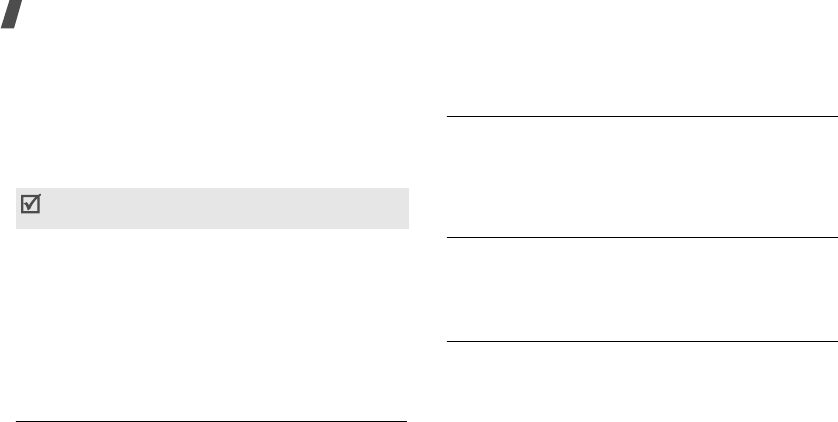
30
Menu functions
•
Change Order
: change the position of the
selected menu.
•
Initialize
: cancel your settings.
Voice Mail
(Menu 7)
Use this menu to connect to the voice mail server and
access your voice mails.
press <
Options
> to access the following options:
•
Listen
: access your voice mail server and listen to
your voice mail.
•
Clear Icon
: clear the received Voice Mail
notification.
Messaging
(Menu 8)
Chat
(Menu 8.1)
Use this menu to use the WAP browser chatting
service.
For further details about this service, contact your
service provider.
Messenger
(Menu 8.2)
Use this menu to access the WAP browser Instant
Messenger (IM) service.
For further details about this service, contact your
service provider.
E-Mail
(Menu 8.3)
Use this menu to use the WAP browser e-mail service.
For further details about this service, contact your
service provider.
Torpedos
(Menu 8.4)
Utilidades
(Menu 9)
Voice Services
(Menu *)
Your service provider can give the voice server
number.

Menu functions
Voice Services
(Menu *)
31
Use this menu to access voice-related features.
To access this menu, press <
Menu
> in Idle mode and
select
Voice Services
.
Voice Portal
(Menu *.1)
Use this menu to access this voice-activated service
and get audio content, such as headline news,
information on movies, the weather, finance, and
traffic, supplied by your service provider.
For further details, contact your service provider.
Voice Information
(Menu *.2)
Voice Command
(Menu *.3)
Your phone can perform functions or access specific
menus via your voice commands.
1. Access the
Voice Command
menu to activate
voice recognition. You can also press and hold [ ]
in Idle mode.
2. State the name of the desired feature.
3. Follow the corresponding menu procedure.
Voice Memo
(Menu *.4)
Use this menu to record voice memos.
Record
(Menu *.4.1)
You can record up to 30 voice memos of up to
1 minute each (or 2Mbyte).
1. Speak into the microphone.
Press <
Pause
> to pause recording.
Press <
Resume
> to resume.
2. When you have finished, press <
Finish
>. After
recording a voice memo, press <
Options
> to
access the following options:
•
Save As
: save the memo.
•
Review
: replay the memo.
•
Rerecord
: discard the current memo and record
another one.
Review
(Menu *.4.2)
You can access and play the memos you have
recorded.
1. Scroll to a voice memo.

32
Menu functions
2. Press [
OK
] to view details, or press <
Options
> to
access the following options:
•
Play
: play the voice memo.
•
Rename
: change the memo name.
•
Delete
: delete the selected memo.
•
Delete All
: delete all memos.
3. Select
Play
.
Delete All
(Menu *.4.3)
You can delete all recorded voice memos at one time.
When a confirmation message appears, press <
Yes
>.
Settings
(Menu *.5)
Use this menu to customize settings for voice tools.
Digit Dialing
(Menu *.5.1)
Use this menu to set the phone to better recognize
your voice for voice dialing, and also to reset settings.
•
Adapt Digits
: adapt your phone to recognize your
vocal style and pronunciation for each digit. Follow
the voice prompts to adapt the phone.
•
Reset Digits
: return to default settings.
Sensitivity
(Menu *.5.2)
Use this menu to adjust the sensitivity level of your
phone to better recognize your voice.
Choice Lists
(Menu *.5.3)
Use this menu to set the phone to require confirmation
of your voice commands when using Name dialing,
Digit dialing or accessing Contacts.
The following options are available for each item:
•
Automatic
: the phone ask for confirmation when
results are not clear.
•
Always On
: the phone ask for confirmation at all
times.
•
Always Off
: the phone does not require
confirmation.
For further information about this feature, press
<
Help
> on each item screen.
Sound
(Menu *.5.4)
Use this menu to configure sound settings for voice
dialing.
•
Prompts
: turn on or off audio prompts.

Menu functions
Other Functions
(Menu 0)
33
•
Digits
: turn on or off audio playback for digit
dialing.
•
Names
: turn on or off audio playback for name
dialing.
•
Name Settings
: adjust settings for the speed and
volume for name dialing.
Voice Launch
(Menu *.5.5)
Use this menu to set how voice dialing is initiated.
•[]
Only
: launch voice dialing by pressing and
holding [ ] in Idle mode.
•[]
/ Folder
: launch voice dialing by pressing and
holding [ ] or by opening the phone.
•[]
/ EarMic
: launch voice dialing by pressing
and holding [ ] or the button on the headset.
About
(Menu *.5.6)
Use this menu to display information about the voice
command programme.
Other Functions
(Menu 0)
Planner
(Menu 0.1)
The calendar feature enables you to keep track of your
schedule and tasks and to make a memo.
Today
(Menu 0.1.1)
Use this menu to display Planner items stored for the
current day on the Today view.
Calendar
(Menu 0.1.2)
When you enter the
Calendar
menu, the calendar in
Month view appears with today’s date.
Task List
(Menu 0.1.3)
Use this menu to create a list of tasks that need to be
done.
Memo Pad
(Menu 0.1.4)
Use this menu to make memos of important things
you need to remember.
Alarms
(Menu 0.1.5)
Use this menu to set alarms to sound at specific times.
A wake-up alarm is not affected by your sound setting.

34
Menu functions
Calculator
(Menu 0.1.6)
Use this menu to perform basic arithmetic functions,
such as addition, subtraction, multiplication, and
division.
Countdown
(Menu 0.1.7)
Use this menu to count how many days are left until a
specific date.
World Time
(Menu 0.1.8)
Use this menu to find out what time it is in another
part of the world.
Scroll through the map by pressing [Left] or [Right].
To apply the DST (Daylight Savings Time) setting,
press <
Set DST
>.
To cancel the setting, press <
Unset DST
>.
Units Conversion
(Menu 0.1.9)
Use this menu for common conversions, such as
currency and temperature.
Stop Watch
(Menu 0.1.0)
Help
(Menu 0.2)
Use this menu to view information about your phone.
•
Version
: display the phone information.
•
Phone Number
: display your phone number.
•
Icon Glossary
: display icons shown on the screen
when you use the phone.
Settings
(Menu #)
Use this menu to customize your phone settings. You
can also reset the settings to their default values.
To access this menu, press <
Menu
> in Idle mode and
select
Settings
.
Display
(Menu #.1)
Use this menu to change settings for the display and
light.
Phone Design
(Menu #.1.1)
Use this menu to change the display properties for
Menu mode and Dial mode.
•
Screen Color
: select the color of the screen.
•
Screen Font
: select the color of the screen font.

Menu functions
Settings
(Menu #)
35
•
Dial Design
: select a color for the digits when
entering a number for dialing.
Idle Screen
(Menu #.1.2)
Use this menu to change display properties for Idle
mode.
•
Wallpaper
: set the background image (wallpaper)
to be displayed in Idle mode.
•
Func. Screen
: set the phone to display one of the
following function screen in Idle mode.
Clock Style
: display a clock.
Calendar
: display the calendar of the current
month.
Today
: display the current day’s Today view.
Launch Pad
: display the shortcut assignments for
the Navigation keys. You can also change the
assignments.
•
Banner
: enter a banner message to be displayed
at the bottom of the display in Idle mode.
Backlight
(Menu #.1.3)
You can select the length of time the backlight stays
on and the time the display remains on in Dimming
mode, in which the backlight is off.
•
LCD
: specify the length of time the display
backlight stays on.
•
Keypad
: specify the length of time the keypad
backlight stays on.
•
Power Save
: set the phone to turn the display off
when you don’t use the phone.
Set Time
(Menu #.1.4)
When you need to manually enter the current time
and date in specific areas where call service reception
is weak, use this menu to set the time and date on the
idle screen. Only then you can use the Planner
features when outside a call service area.
Enter the time and date using the numeric keys and
press <
Set
>.
Service LED
(Menu #.1.5)
The service light on the front of the phone, blinks to
indicate the service status. In this menu, you can
activate or deactivate the feature of the service light.
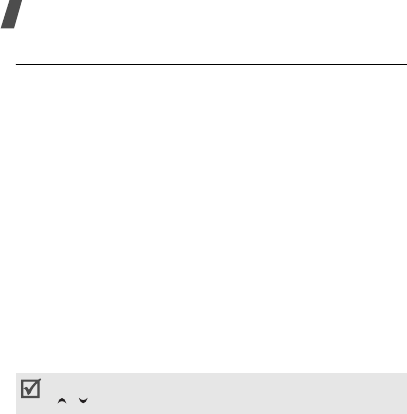
36
Menu functions
Sounds
(Menu #.2)
Use this menu to customize various sound settings.
Volume
(Menu #.2.1)
Use this menu to select a ringer volume for incoming
calls, message alert, alarms, key tone, depending on
the place where you are.
•
Silent
: the phone does not ring.
•
1-Beep
: the phone sound a beep.
•
Vibrate
: the phone vibrates but not rings.
•
Level 1
~
8
: select a volume for the call ringer. The
more bars, the louder the volume.
•
Vib+Ring
: the phone vibrates and then rings.
Type
(Menu #.2.2)
Use this menu to select the ringer type for incoming
calls, roaming, message alert, key tone, or data calls.
Alerts
(Menu #.2.3)
Use this menu to have the phone alert (beep) you to
inform you that certain things have happened.
•
Tone Length
: set short or long DTMF (dual-tone
multi-frequency) tones to be sent to access
teleservices, such as a bank account. If the service
is digital, as most are, short DTMF tones will
almost always work.
•
Service
: set the phone to beep when you exit a
service area or return to a service area.
•
Connect
: set the phone to beep when your call is
connected to the system.
•
Disconnect
: set the phone to beep when your call
is disconnected from the system.
•
Signal Fade
: set the phone to beep when a
dropped call occurs during conversation in
response to fading signal strength.
•
Minute Beep
: set the phone to beep every minute
during an outgoing call to keep you informed of the
length of your call.
•
Folder Sound
: set the phone to sound an alert
when you open or close the phone.
You can adjust the keypad tone volume using
[/]
in Idle mode.
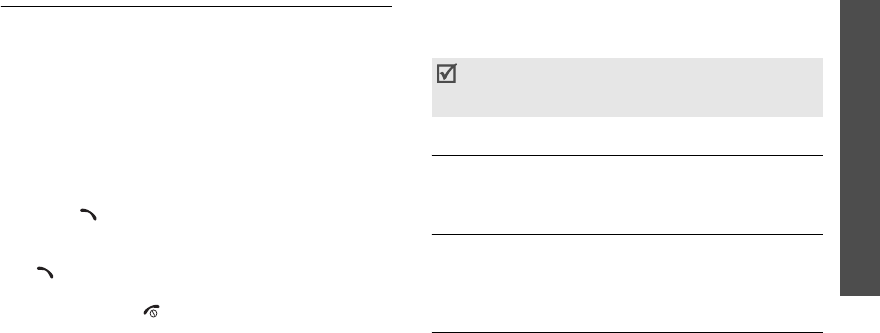
Menu functions
Settings
(Menu #)
37
•
Power On/Off
: set the phone to sound an alert
when you turn on or off the phone.
Call Setup
(Menu #.3)
Use this menu to customize the phone for making and
receiving calls.
Auto Answer
(Menu #.3.1)
Use this menu to set the phone to automatically
answer calls after a specified time when you use the
headset or an optional hands-free car kit.
Call Answer
(Menu #.3.2)
Use this menu to set how to answer incoming calls.
•
Send Key
: the phone answers calls only when you
press [
]
or <
Answer
>.
•
Folder Open
: the phone answers when you open
the phone. If the phone is already open, press
[
]
or <
Answer
>.
•
Any Key
: the phone answers when you press any
key except for [
]
, <
Ignore
>, and the Volume
keys.
Auto Retry
(Menu #.3.3)
Use this menu to set the phone to automatically redial
calls when a connection fails.
Auto CSP
(Menu #.3.4)
Use this menu to set the phone to automatically add
the CSP (Carrier Selection Code) of your long distance
call service to the entered number when making a call.
Language
(Menu #.4)
Use this menu to select one of several languages for
the display text.
Vivo Encontra
(Menu #.5)
Use this menu to activate LBS (Location Based
Services) to find current position information or to let
other devices locate you.
WAP Setup
(Menu #.6)
The code is added only when the phone number has
6,7,10, or 11 digits and starts with 0xx, for
example, 012 or 015.
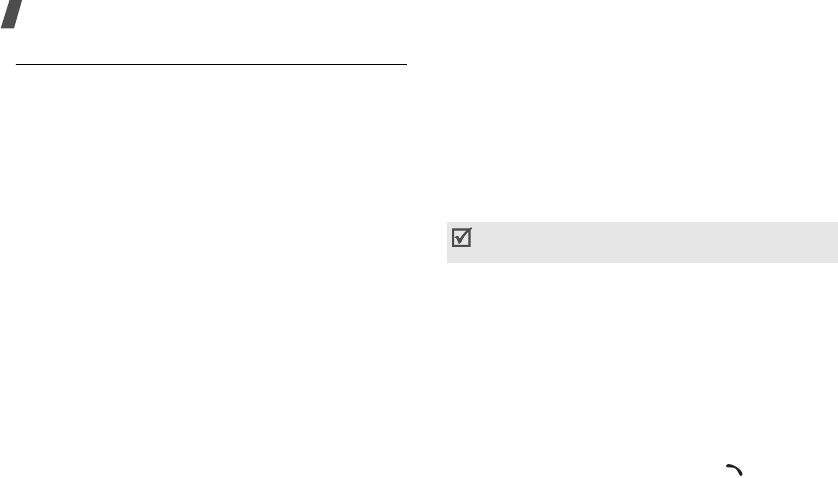
38
Menu functions
Security
(Menu #.7)
Use this menu to protect the phone against
unauthorized use.
To access the
Security
menu, you must enter the
phone password. The password is preset to
0000
.
Lock Phone
(Menu #.7.1)
Use this menu to lock the phone.
•
Unlock
: the phone remains unlocked.
•
On Power-Up
: the phone is locked automatically
each time you turn it on.
•
Lock Now
: the phone is lock immediately.
When the phone is locked, you must enter your phone
password each time you access menu functions.
Change Pwd
(Menu #.7.2)
Use this menu to change your phone password. The
password is preset to
0000
.
Restriction
(Menu #.7.3)
Use this menu to restrict all call functions on the
phone and access to your Contacts.
When this feature is enabled, you must enter the
phone password to access restricted functions. The
password is preset to
0000
.
Modem
(Menu #.7.4)
Your phone can be used as a standard modem on a PC
for sending and receiving digital data when connected
to a Windows computer. Using your phone as a
modem, you can wirelessly access data from Windows
software applications.
Use this menu to change the phone mode for being
used as a modem.
•
Voice Call Only
: receive voice calls only.
•
Data in Only
: receive data calls only.
Emergency #
(Menu #.7.5)
Use this menu to store emergency numbers, which
can be manually dialed at any time even if all call
functions are restricted or your phone is in Lock mode.
To make a emergency call in Lock mode, enter a
programmed number and then press [
]
.
The phone must be on a digital network to receive
or send data.
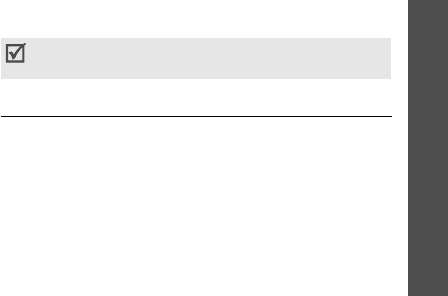
Menu functions
Settings
(Menu #)
39
IMPORTANT NOTICE
Emergency calling may not be available on all wireless
networks at all times. A connection cannot always be
guaranteed, due to various transmission methods,
network parameters, and user settings used to
complete a call from your wireless phone.
DO NOT depend on this phone as a primary method of
dialing 190 or for any other essential or emergency
communications.
Remember to always turn your phone on and check for
adequate signal strength before placing a call.
Erase Memory
(Menu #.7.6)
Use this menu to erase all data stored in the phone’s
memory.
1. Select a data type and press [
OK
] to check data to
be deleted.
2. Press <
Del
>.
3. Press <
Yes
> to confirm the deletion.
Reset Phone
(Menu #.7.7)
Use this menu to reset the original phone settings,
display settings, and sound settings individually. You
can also reset all the settings in your phone at the
same time.
System
(Menu #.8)
This menu provides you with options for selecting a
network.
Set System
(Menu #.8.1)
Roaming allows you to register your phone on other
networks and use the facilities, if your own network is
not available. Roaming is only relevant in areas where
there are at least two cellular service providers having
valid roaming agreements.
The password is preset to
0000
. You can change
this password
p. 38

40
Menu functions
When you are using another network, the Roaming
icon ( ) appears.
•
Home Only
: you cannot roam. When your home
system is not available, and the No service icon
( ) appears and you cannot make or receive
calls.
•
Standard
: your phone automatically searches for
the first available service.
Set NAM
(Menu #.8.2)
Your phone can have two NAMs (Numberical
Assignment Module), essentially your phone number.
Use this menu to switch your service back and forth
between the two.
If you change the NAM, the phone turns off by itself
and then back on to acquire service using the new
NAM.
PRL Enabled
(Menu #.8.3)
Your phone can find a cellular service provider's
network on the Preferred Roaming List (PRL), a graded
list of bands and channels which the phone uses when
it attempts to locate and connect to a network while
roaming. In this menu, you can activate or deactivate
the use of the PRL.
•
Yes
: the phone searches and lists all of the
network providers' networks available for your
area.
•
No
: the phone searches for the default channel to
locate your own network.
Pref Mode
(Menu #.8.4)
Use this menu to select the network to be used when
roaming.
•
Hybrid
: the phone uses both the 1XRTT and EVDO
network.
•
CDMA Only
: the phone uses the 1XRTT network.
•
EVDO Only
: the phone uses the EVDO network.
Bluetooth
(Menu #.9)
Bluetooth technology enables cost-free
wirelessconnections between electronic devices within
a maximum range of 10 meters. A Bluetooth
connection can be used to send photos, images,

Menu functions
Settings
(Menu #)
41
videos, phonebook, scheduled items, and to connect
wirelessly to devices using Bluetooth technology, such
as computers. Since Bluetooth devices communicate
using radio waves, your phone and the other Bluetooth
device do not need to be in line of sight to each other.
The 2 devices only need to be within a maximum of 10
meters of each other, although the connection can be
subjected to interference from obstructions, such as
walls or other electronic devices. In some countries,
there may be restrictions on using Bluetooth
devices.Please contact your service provider.
Activation
(Menu #.9.1)
This feature allows you to activate the Bluetooth
feature. When this option is set to on, the Bluetooth
icon appears.
Search
(Menu #.9.2)
This feature allows you to search the Bluetooth device.
Disconnect
(Menu #.9.3)
Registered List
(Menu #.9.4)
This feature allows you to view the registered
Bluetooth devices.
Settings
(Menu #.9.3)
My Device name
This feature allows you to change your phone’s
Bluetooth device name, which is displayed on other
devices.
Visibility
Security
This feature allows you to select whether or not the
phone asks for your confirmation when other devices
access your data.
Mode

42
Health and safety information
Exposure to Radio Frequency (RF) Signals
Certification Information (SAR)
Your wireless phone is a radio transmitter and receiver.
It is designed and manufactured not to exceed the
exposure limits for radio frequency (RF) energy set by
the Federal Communications Commission (FCC) of the
U.S. government. These FCC exposure limits are
derived from the recommendations of two expert
organizations, the National Counsel on Radiation
Protection and Measurement (NCRP) and the Institute
of Electrical and Electronics Engineers (IEEE). In both
cases, the recommendations were developed by
scientific and engineering experts drawn from
industry, government, and academia after extensive
reviews of the scientific literature related to the
biological effects of RF energy.
The exposure limit set by the FCC for wireless mobile
phones employs a unit of measurement known as the
Specific Absorption Rate (SAR). The SAR is a measure
of the rate of absorption of RF energy by the human
body expressed in units of watts per kilogram (W/kg).
The FCC requires wireless phones to comply with a
safety limit of 1.6 watts per kilogram (1.6 W/kg). The
FCC exposure limit incorporates a substantial margin
of safety to give additional protection to the public and
to account for any variations in measurements.
SAR tests are conducted using standard operating
positions accepted by the FCC with the phone
transmitting at its highest certified power level in all
tested frequency bands. Although the SAR is
determined at the highest certified power level, the
actual SAR level of the phone while operating can be
well below the maximum value. This is because the
phone is designed to operate at multiple power levels
so as to use only the power required to reach the
network. In general, the closer you are to a wireless
base station antenna, the lower the power output.

Health and safety information
43
Before a new model phone is available for sale to the
public, it must be tested and certified to the FCC that
it does not exceed the exposure limit established by
the FCC. Tests for each model phone are performed in
positions and locations (e.g. at the ear and worn on
the body) as required by the FCC.
The highest SAR values for this model phone as
reported to the FCC are Head: 1.34 W/Kg, Body-
worn: 0.924 W/Kg.
For body worn operation, this model phone has been
tested and meets the FCC RF exposure guidelines
whenused with a Samsung accessory designated for
this product or when used with an accessory that
contains no metal and that positions the handset a
minimum of 1.5 cm from the body.
Non-compliance with the above restrictions may result
in violation of FCC RF exposure guidelines.
SAR information on this and other model phones can
be viewed on-line at www.fcc.gov/oet/fccid. This site
uses the phone FCC ID number, A3LSCHA915.
Sometimes it may be necessary to remove the battery
pack to find the number. Once you have the FCC ID
number for a particular phone, follow the instructions
on the website and it should provide values for typical
or maximum SAR for a particular phone. Additional
product specific SAR information can also be obtained
at www.fcc.gov/cgb/sar.

44
Health and safety information
Consumer Information on Wireless Phones
The U.S. Food and Drug Administration (FDA) has
published a series of Questions and Answers for
consumers relating to radio frequency (RF) exposure
from wireless phones. The FDA publication includes
the following information:
What kinds of phones are the subject of this
update?
The term wireless phone refers here to hand-held
wireless phones with built-in antennas, often called
“cell,” “mobile,” or “PCS” phones. These types of
wireless phones can expose the user to measurable
radio frequency energy (RF) because of the short
distance between the phone and the user's head.
These RF exposures are limited by Federal
Communications Commission safety guidelines that
were developed with the advice of FDA and other
federal health and safety agencies. When the phone is
located at greater distances from the user, the
exposure to RF is drastically lower because a person's
RF exposure decreases rapidly with increasing
distance from the source. The so-called “cordless
phones,” which have a base unit connected to the
telephone wiring in a house, typically operate at far
lower power levels, and thus produce RF exposures
well within the FCC's compliance limits.
Do wireless phones pose a health hazard?
The available scientific evidence does not show that
any health problems are associated with using
wireless phones. There is no proof, however, that
wireless phones are absolutely safe. Wireless phones
emit low levels of radio frequency energy (RF) in the
microwave range while being used. They also emit
very low levels of RF when in the stand-by mode.
Whereas high levels of RF can produce health effects
(by heating tissue), exposure to low level RF that does
not produce heating effects causes no known adverse
health effects. Many studies of low level RF exposures
have not found any biological effects. Some studies
have suggested that some biological effects may
occur, but such findings have not been confirmed by
additional research. In some cases, other researchers
have had difficulty in reproducing those studies, or in
determining the reasons for inconsistent results.

Health and safety information
45
What is FDA's role concerning the safety of
wireless phones?
Under the law, FDA does not review the safety of
radiation-emitting consumer products such as wireless
phones before they can be sold, as it does with new
drugs or medical devices. However, the agency has
authority to take action if wireless phones are shown
to emit radio frequency energy (RF) at a level that is
hazardous to the user. In such a case, FDA could
require the manufacturers of wireless phones to notify
users of the health hazard and to repair, replace or
recall the phones so that the hazard no longer exists.
Although the existing scientific data do not justify FDA
regulatory actions, FDA has urged the wireless phone
industry to take a number of steps, including the
following:
• “Support needed research into possible biological
effects of RF of the type emitted by wireless
phones;
• “Design wireless phones in a way that minimizes
any RF exposure to the user that is not necessary
for device function; and
• “Cooperate in providing users of wireless phones
with the best possible information on possible
effects of wireless phone use on human health.
FDA belongs to an interagency working group of the
federal agencies that have responsibility for different
aspects of RF safety to ensure coordinated efforts at
the federal level. The following agencies belong to this
working group:
• “National Institute for Occupational Safety and
Health
• “Environmental Protection Agency
• “Federal Communications Commission
• “Occupational Safety and Health Administration
• “National Telecommunications and Information
Administration
The National Institutes of Health participates in some
interagency working group activities, as well.
FDA shares regulatory responsibilities for wireless
phones with the Federal Communications Commission
(FCC). All phones that are sold in the United States
must comply with FCC safety guidelines that limit RF

46
Health and safety information
exposure. FCC relies on FDA and other health agencies
for safety questions about wireless phones.
FCC also regulates the base stations that the wireless
phone networks rely upon. While these base stations
operate at higher power than do the wireless phones
themselves, the RF exposures that people get from
these base stations are typically thousands of times
lower than those they can get from wireless phones.
Base stations are thus not the primary subject of the
safety questions discussed in this document.
What are the results of the research done
already?
The research done thus far has produced conflicting
results, and many studies have suffered from flaws in
their research methods. Animal experiments
investigating the effects of radio frequency energy
(RF) exposures characteristic of wireless phones have
yielded conflicting results that often cannot be
repeated in other laboratories. A few animal studies,
however, have suggested that low levels of RF could
accelerate the development of cancer in laboratory
animals. However, many of the studies that showed
increased tumor development used animals that had
been genetically engineered or treated with cancer-
causing chemicals so as to be pre-disposed to develop
cancer in absence of RF exposure. Other studies
exposed the animals to RF for up to 22 hours per day.
These conditions are not similar to the conditions
under which people use wireless phones, so we don't
know with certainty what the results of such studies
mean for human health.
Three large epidemiology studies have been published
since December 2000. Between them, the studies
investigated any possible association between the use
of wireless phones and primary brain cancer, glioma,
meningioma, or acoustic neuroma, tumors of the brain
or salivary gland, leukemia, or other cancers. None of
the studies demonstrated the existence of any harmful
health effects from wireless phones RF exposures.
However, none of the studies can answer questions
about long-term exposures, since the average period
of phone use in these studies was around three years.

Health and safety information
47
What research is needed to decide whether RF
exposure from wireless phones poses a health
risk?
A combination of laboratory studies and
epidemiological studies of people actually using
wireless phones would provide some of the data that
are needed. Lifetime animal exposure studies could be
completed in a few years. However, very large
numbers of animals would be needed to provide
reliable proof of a cancer promoting effect if one
exists. Epidemiological studies can provide data that is
directly applicable to human populations, but ten or
more years' follow-up may be needed to provide
answers about some health effects, such as cancer.
This is because the interval between the time of
exposure to a cancer-causing agent and the time
tumors develop - if they do - may be many, many
years. The interpretation of epidemiological studies is
hampered by difficulties in measuring actual RF
exposure during day-to-day use of wireless phones.
Many factors affect this measurement, such as the
angle at which the phone is held, or which model of
phone is used.
What is FDA doing to find out more about the
possible health effects of wireless phone RF?
FDA is working with the U.S. National Toxicology
Program and with groups of investigators around the
world to ensure that high priority animal studies are
conducted to address important questions about the
effects of exposure to radio frequency energy (RF).
FDA has been a leading participant in the World Health
Organization international Electromagnetic Fields
(EMF) Project since its inception in 1996. An influential
result of this work has been the development of a
detailed agenda of research needs that has driven the
establishment of new research programs around the
world. The Project has also helped develop a series of
public information documents on EMF issues.
FDA and Cellular Telecommunications & Internet
Association (CTIA) have a formal Cooperative
Research and Development Agreement (CRADA) to do
research on wireless phone safety. FDA provides the
scientific oversight, obtaining input from experts in
government, industry, and academic organizations.
CTIA-funded research is conducted through contracts

48
Health and safety information
to independent investigators. The initial research will
include both laboratory studies and studies of wireless
phone users. The CRADA will also include a broad
assessment of additional research needs in the
context of the latest research developments around
the world.
What steps can I take to reduce my exposure
to radio frequency energy from my wireless
phone?
If there is a risk from these products - and at this
point we do not know that there is - it is probably very
small. But if you are concerned about avoiding even
potential risks, you can take a few simple steps to
minimize your exposure to radio frequency energy
(RF). Since time is a key factor in how much exposure
a person receives, reducing the amount of time spent
using a wireless phone will reduce RF exposure.
• “If you must conduct extended conversations by
wireless phone every day, you could place more
distance between your body and the source of the
RF, since the exposure level drops off dramatically
with distance. For example, you could use a
headset and carry the wireless phone away from
your body or use a wireless phone connected to a
remote antenna.
Again, the scientific data do not demonstrate that
wireless phones are harmful. But if you are concerned
about the RF exposure from these products, you can
use measures like those described above to reduce
your RF exposure from wireless phone use.
What about children using wireless phones?
The scientific evidence does not show a danger to
users of wireless phones, including children and
teenagers. If you want to take steps to lower exposure
to radio frequency energy (RF), the measures
described above would apply to children and
teenagers using wireless phones. Reducing the time of
wireless phone use and increasing the distance
between the user and the RF source will reduce RF
exposure.
Some groups sponsored by other national
governments have advised that children be
discouraged from using wireless phones at all. For

Health and safety information
49
example, the government in the United Kingdom
distributed leaflets containing such a recommendation
in December 2000. They noted that no evidence exists
that using a wireless phone causes brain tumors or
other ill effects. Their recommendation to limit
wireless phone use by children was strictly
precautionary; it was not based on scientific evidence
that any health hazard exists.
Do hands-free kits for wireless phones reduce
risks from exposure to RF emissions?
Since there are no known risks from exposure to RF
emissions from wireless phones, there is no reason to
believe that hands-free kits reduce risks. Hands-free
kits can be used with wireless phones for convenience
and comfort. These systems reduce the absorption of
RF energy in the head because the phone, which is the
source of the RF emissions, will not be placed against
the head. On the other hand, if the phone is mounted
against the waist or other part of the body during use,
then that part of the body will absorb more RF energy.
Wireless phones marketed in the U.S. are required to
meet safety requirements regardless of whether they
are used against the head or against the body. Either
configuration should result in compliance with the
safety limit.
Do wireless phone accessories that claim to
shield the head from RF radiation work?
Since there are no known risks from exposure to RF
emissions from wireless phones, there is no reason to
believe that accessories that claim to shield the head
from those emissions reduce risks. Some products
that claim to shield the user from RF absorption use
special phone cases, while others involve nothing
more than a metallic accessory attached to the phone.
Studies have shown that these products generally do
not work as advertised. Unlike “hand-free” kits, these
so-called “shields” may interfere with proper operation
of the phone. The phone may be forced to boost its
power to compensate, leading to an increase in RF
absorption. In February 2002, the Federal trade
Commission (FTC) charged two companies that sold
devices that claimed to protect wireless phone users
from radiation with making false and unsubstantiated

50
Health and safety information
claims. According to FTC, these defendants lacked a
reasonable basis to substantiate their claim.
What about wireless phone interference with
medical equipment?
Radio frequency energy (RF) from wireless phones can
interact with some electronic devices. For this reason,
FDA helped develop a detailed test method to measure
electromagnetic interference (EMI) of implanted
cardiac pacemakers and defibrillators from wireless
telephones. This test method is now part of a standard
sponsored by the Association for the Advancement of
Medical instrumentation (AAMI). The final draft, a joint
effort by FDA, medical device manufacturers, and
many other groups, was completed in late 2000. This
standard will allow manufacturers to ensure that
cardiac pacemakers and defibrillators are safe from
wireless phone EMI. FDA has tested wireless phones
and helped develop a voluntary standard sponsored by
the Institute of Electrical and Electronic Engineers
(IEEE). This standard specifies test methods and
performance requirements for hearing aids and
wireless phones so that no interference occurs when a
person uses a compatible phone and a compatible
hearing aid at the same time. This standard was
approved by the IEEE in 2000.
FDA continues to monitor the use of wireless phones
for possible interactions with other medical devices.
Should harmful interference be found to occur, FDA
will conduct testing to assess the interference and
work to resolve the problem.
Additional information on the safety of RF exposures
from various sources can be obtained from the
following organizations:
• FCC RF Safety Program:
http://www.fcc.gov/oet/rfsafety/
• Environmental Protection Agency (EPA):
http://www.epa.gov/radiation/
• Occupational Safety and Health Administration's
(OSHA):
http://www.osha.gov/SLTC/
radiofrequencyradiation/index.html

Health and safety information
51
• National institute for Occupational Safety and
Health (NIOSH):
http://www.cdc.gov/niosh/emfpg.html
• World health Organization (WHO):
http://www.who.int/peh-emf/
• International Commission on Non-Ionizing
Radiation Protection:
http://www.icnirp.de
• National Radiation Protection Board (UK):
http://www.nrpb.org.uk
• Updated 4/3/2002: US food and Drug
Administration
http://www.fda.gov/cellphones
Road Safety
Your wireless phone gives you the powerful ability to
communicate by voice, almost anywhere, anytime.
But an important responsibility accompanies the
benefits of wireless phones, one that every user must
uphold.
When driving a car, driving is your first responsibility.
When using your wireless phone behind the wheel of a
car, practice good common sense and remember the
following tips:
1. Get to know your wireless phone and its features,
such as speed dial and redial. If available, these
features help you to place your call without taking
your attention off the road.
2. When available, use a hands-free device. If
possible, add an additional layer of convenience
and safety to your wireless phone with one of the
many hands free accessories available today.

52
Health and safety information
3. Position your wireless phone within easy reach. Be
able to access your wireless phone without
removing your eyes from the road. If you get an
incoming call at an inconvenient time, let your
voice mail answer it for you.
4. Let the person you are speaking with know you are
driving; if necessary, suspend the call in heavy
traffic or hazardous weather conditions. Rain,
sleet, snow, ice and even heavy traffic can be
hazardous.
5. Do not take notes or look up phone numbers while
driving. Jotting down a “to do” list or flipping
through your address book takes attention away
from your primary responsibility, driving safely.
6. Dial sensibly and assess the traffic; if possible,
place calls when you are not moving or before
pulling into traffic. Try to plan calls when your car
will be stationary. If you need to make a call while
moving, dial only a few numbers, check the road
and your mirrors, then continue.
7. Do not engage in stressful or emotional
conversations that may be distracting. Make
people you are talking with aware you are driving
and suspend conversations that have the potential
to divert your attention from the road.
8. Use your wireless phone to call for help. Dial 9-1-1
or other local emergency number in the case of
fire, traffic accident or medical emergencies.
Remember, it is a free call on your wireless phone!
9. Use your wireless phone to help others in
emergencies. If you see an auto accident, crime in
progress or other serious emergency where lives
are in danger, call 9-1-1 or other local emergency
number, as you would want others to do for you.
10.Call roadside assistance or a special non-
emergency wireless assistance number when
necessary. If you see a broken-down vehicle
posing no serious hazard, a broken traffic signal, a
minor traffic accident where no one appears
injured, or a vehicle you know to be stolen, call
roadside assistance or other special non-
emergency number.

Health and safety information
53
“The wireless industry reminds you to use your
phone safely when driving.”
For more information, please call 1-888-901-SAFE, or
visit our web-site www.wow-com.com
Provided by the Cellular Telecommunications &
Internet Association
Operating Environment
Remember to follow any special regulations in force in
any area and always switch your phone off whenever it
is forbidden to use it, or when it may cause
interference or danger. When connecting the phone or
any accessory to another device, read its user's guide
for detailed safety instructions. Do not connect
incompatible products.
As with other mobile radio transmitting equipment,
users are advised that for the satisfactory operation of
the equipment and for the safety of personnel, it is
recommended that the equipment should only be used
in the normal operating position (held to your ear with
the antenna pointing over your shoulder).
Using Your Phone Near Other Electronic
Devices
Most modern electronic equipment is shielded from
radio frequency (RF) signals. However, certain
electronic equipment may not be shielded against the
RF signals from your wireless phone. Consult the
manufacturer to discuss alternatives.
Pacemakers
Pacemaker manufacturers recommend that a
minimum distance of 15 cm (6 inches) be maintained
between a wireless phone and a pacemaker to avoid
potential interference with the pacemaker.
These recommendations are consistent with the
independent research and recommendations of
Wireless Technology Research.
Persons with pacemakers:
• should always keep the phone more than 15 cm
(6 inches) from their pacemaker when the phone is
switched on.
• should not carry the phone in a breast pocket.

54
Health and safety information
• should use the ear opposite the pacemaker to
minimize potential interference.
If you have any reason to suspect that interference is
taking place, switch your phone off immediately.
Hearing Aids
Some digital wireless phones may interfere with some
hearing aids. In the event of such interference, you
may wish to consult your hearing aid manufacturer to
discuss alternatives.
Other Medical Devices
If you use any other personal medical devices, consult
the manufacturer of your device to determine if it is
adequately shielded from external RF energy. Your
physician may be able to assist you in obtaining this
information. Switch your phone off in health care
facilities when any regulations posted in these areas
instruct you to do so. Hospitals or health care facilities
may be using equipment that could be sensitive to
external RF energy.
Vehicles
RF signals may affect improperly installed or
inadequately shielded electronic systems in motor
vehicles. Check with the manufacturer or its
representative regarding your vehicle. You should also
consult the manufacturer of any equipment that has
been added to your vehicle.
Posted Facilities
Switch your phone off in any facility where posted
notices require you to do so.
Potentially Explosive Environments
Switch your phone off when in any area with a
potentially explosive atmosphere and obey all signs
and instructions. Sparks in such areas could cause an
explosion or fire resulting in bodily injury or even
death.
Users are advised to switch the phone off while at a
refueling point (service station). Users are reminded of
the need to observe restrictions on the use of radio
equipment in fuel depots (fuel storage and distribution

55
areas), chemical plants or where blasting operations
are in progress.
Areas with a potentially explosive atmosphere are
often but not always clearly marked. They include
below deck on boats, chemical transfer or storage
facilities, vehicles using liquefied petroleum gas (such
as propane or butane), areas where the air contains
chemicals or particles, such as grain, dust or metal
powders, and any other area where you would
normally be advised to turn off your vehicle engine.
Emergency Calls
This phone, like any wireless phone, operates using
radio signals, wireless and landline networks as well as
user programmed functions, which cannot guarantee
connection in all conditions. Therefore, you should
never rely solely on any wireless phone for essential
communications (medical emergencies, for example).
Remember, to make or receive any calls the phone
must be switched on and in a service area with
adequate signal strength. Emergency calls may not be
possible on all wireless phone networks or when
certain network services and/or phone features are in
use. Check with local service providers.
To make an emergency call:
1. If the phone is not on, switch it on.
2. Key in the emergency number for your present
location (for example, 911 or other official
emergency number). Emergency numbers vary by
location.
3. Press .
If certain features are in use (call barring, for
example), you may first need to deactivate those
features before you can make an emergency call.
Consult this document and your local cellular service
provider.
When making an emergency call, remember to give all
the necessary information as accurately as possible.
Remember that your phone may be the only means of
communication at the scene of an accident; do not cut
off the call until given permission to do so.
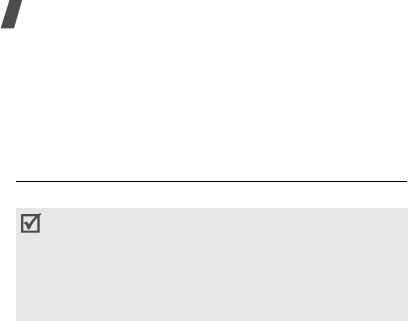
56
Health and safety information
Restricting Children's access to your Phone
Your phone is not a toy. Children should not be allowed
to play with it because they could hurt themselves and
others, damage the phone or make calls that increase
your phone bill.
FCC Notice and Cautions
FCC Notice
The phone may cause TV or radio interference if used
in close proximity to receiving equipment. The FCC
can require you to stop using the phone if such
interference cannot be eliminated.
Vehicles using liquefied petroleum gas (such as
propane or butane) must comply with the National Fire
Protection Standard (NFPA-58). For a copy of this
standard, contact the National Fire Protection
Association, One Battery march Park, Quincy, MA
02269, Attn: Publication Sales Division.
Cautions
Changes or modifications made in the radio phone, not
expressly approved by Samsung, will void the user’s
authority to operate the equipment.
Only use approved batteries, antennas and chargers.
The use of any unauthorized accessories may be
dangerous and void the phone warranty if said
accessories cause damage or a defect to the phone.
Although your phone is quite sturdy, it is a complex
piece of equipment and can be broken. Avoid
dropping, hitting, bending or sitting on it.
This device complies with Part 15 of the FCC Rules.
Operation is subject to the following two
conditions: (1) this device may not cause harmful
interference, and (2) this device must accept any
interference received, including interference that
may cause undesired operation.

57
Other Important Safety Information
• Only qualified personnel should service the phone
or install the phone in a vehicle. Faulty installation
or service may be dangerous and may invalidate
any warranty applicable to the device.
• Check regularly that all wireless phone equipment
in your vehicle is mounted and operating properly.
• Do not store or carry flammable liquids, gases or
explosive materials in the same compartment as
the phone, its parts or accessories.
• For vehicles equipped with an air bag, remember
that an air bag inflates with great force. Do not
place objects, including both installed or portable
wireless equipment in the area over the air bag or
in the air bag deployment area. If wireless
equipment is improperly installed and the air bag
inflates, serious injury could result.
• Switch your phone off before boarding an aircraft.
The use of wireless phone in aircraft is illegal and
may be dangerous to the aircraft's operation.
• Failure to observe these instructions may lead to
the suspension or denial of telephone services to
the offender, or legal action, or both.
Product Performance
Getting the Most Out of Your Signal Reception
The quality of each call you make or receive depends
on the signal strength in your area. Your phone
informs you of the current signal strength by
displaying a number of bars next to the signal strength
icon. The more bars displayed, the stronger the signal.
If you're inside a building, being near a window may
give you better reception.
Understanding the Power Save Feature
If your phone is unable to find a signal after 15
minutes of searching, a Power Save feature is
automatically activated. If your phone is active, it
periodically rechecks service availability or you can
check it yourself by pressing any key.
Anytime the Power Save feature is activated, a
message displays on the screen. When a signal is
found, your phone returns to standby mode.

58
Health and safety information
Understanding How Your Phone Operates
Your phone is basically a radio transmitter and
receiver. When it's turned on, it receives and transmits
radio frequency (RF) signals. When you use your
phone, the system handling your call controls the
power level. This power can range from 0.006 watts to
0.2 watts in digital mode.
Maintaining Your Phone's Peak Performance
For the best care of your phone, only authorized
personnel should service your phone and accessories.
Faulty service may void the warranty.
There are several simple guidelines to operating your
phone properly and maintaining safe, satisfactory
service.
• Hold the phone with the antenna raised, fully-
extended and over your shoulder.
• Try not to hold, bend or twist the phone's antenna.
• Don't use the phone if the antenna is damaged.
• Speak directly into the phone's receiver.
• Avoid exposing your phone and accessories to rain
or liquid spills. If your phone does get wet,
immediately turn the power off and remove the
battery. If it is inoperable, call Customer Care for
service.
Availability of Various Features/Ring
Tones
Many services and features are network dependent
and may require additional subscription and/or usage
charges. Not all features are available for purchase or
use in all areas. Downloadable Ring Tones may be
available at an additional cost. Other conditions and
restrictions may apply. See your service provider for
additional information.
Battery Standby and Talk Time
Standby and talk times will vary depending on phone
usage patterns and conditions. Battery power
consumption depends on factors such as network
configuration, signal strength, operating temperature,
features selected, frequency of calls, and voice, data,
and other application usage patterns.

Health and safety information
59
Battery Precautions
• Never use any charger or battery that is damaged
in any way.
• Use the battery only for its intended purpose.
• If you use the phone near the network's base
station, it uses less power; talk and standby time
are greatly affected by the signal strength on the
cellular network and the parameters set by the
network operator.
• Battery charging time depends on the remaining
battery charge and the type of battery and charger
used. The battery can be charged and discharged
hundreds of times, but it will gradually wear out.
When the operation time (talk time and standby
time) is noticeably shorter than normal, it is time
to buy a new battery.
• If left unused, a fully charged battery will
discharge itself over time.
• Use only Samsung-approved batteries and
recharge your battery only with Samsung-
approved chargers. When a charger is not in use,
disconnect it from the power source. Do not leave
the battery connected to a charger for more than a
week, since overcharging may shorten its life.
• Extreme temperatures will affect the charging
capacity of your battery: it may require cooling or
warming first.
• Do not leave the battery in hot or cold places, such
as in a car in summer or winter conditions, as you
will reduce the capacity and lifetime of the battery.
Always try to keep the battery at room
temperature. A phone with a hot or cold battery
may temporarily not work, even when the battery
is fully charged. Li-ion batteries are particularly
affected by temperatures below 0 °C (32 °F).
• Do not short-circuit the battery. Accidental short-
circuiting can occur when a metallic object (coin,
clip or pen) causes a direct connection between the
+ and - terminals of the battery (metal strips on
the battery), for example when you carry a spare
battery in a pocket or bag. Short-circuiting the
terminals may damage the battery or the object
causing the short-circuiting.

60
Health and safety information
• Dispose of used batteries in accordance with local
regulations. In some areas, the disposal of
batteries in household or business trash may be
prohibited. For safe disposal options for Li-Ion
batteries, contact your nearest Samsung
authorized service center. Always recycle. Do not
dispose of batteries in a fire.
Care and Maintenance
Your phone is a product of superior design and
craftsmanship and should be treated with care. The
suggestions below will help you fulfill any warranty
obligations and allow you to enjoy this product for
many years.
• Keep the phone and all its parts and accessories
out of the reach of small children.
• Keep the phone dry. Precipitation, humidity and
liquids contain minerals that will corrode electronic
circuits.
• Do not use the phone with a wet hand. Doing so
may cause an electric shock to you or damage to
the phone.
• Do not use or store the phone in dusty, dirty areas,
as its moving parts may be damaged.
• Do not store the phone in hot areas. High
temperatures can shorten the life of electronic
devices, damage batteries, and warp or melt
certain plastics.
• Do not store the phone in cold areas. When the
phone warms up to its normal operating
temperature, moisture can form inside the phone,
which may damage the phone's electronic circuit
boards.
• Do not drop, knock or shake the phone. Rough
handling can break internal circuit boards.
• Do not use harsh chemicals, cleaning solvents or
strong detergents to clean the phone. Wipe it with
a soft cloth slightly dampened in a mild soap-and-
water solution.

Health and safety information
61
• Do not paint the phone. Paint can clog the device's
moving parts and prevent proper operation.
• Do not put the phone in or on heating devices,
such as a microwave oven, a stove or a radiator.
The phone may explode when overheated.
• When the phone or battery gets wet, the label
indicating water damage inside the phone changes
color. In this case, phone repairs are no longer
guaranteed by the manufacturer's warranty, even
if the warranty for your phone has not expired.
• If your phone has a flash or light, do not use it too
close to the eyes of people or animals. This may
cause damage to their eyes.
• Use only the supplied or an approved replacement
antenna. Unauthorized antennas or modified
accessories may damage the phone and violate
regulations governing radio devices.
• If the phone, battery, charger or any accessory is
not working properly, take it to your nearest
qualified service facility. The personnel there will
assist you, and if necessary, arrange for service.